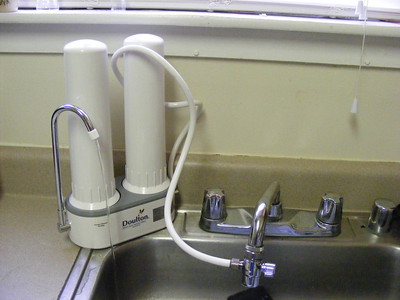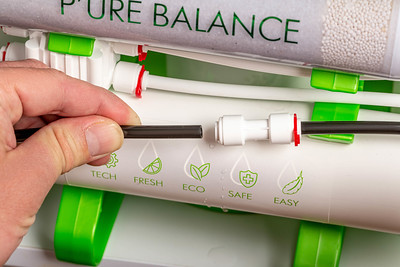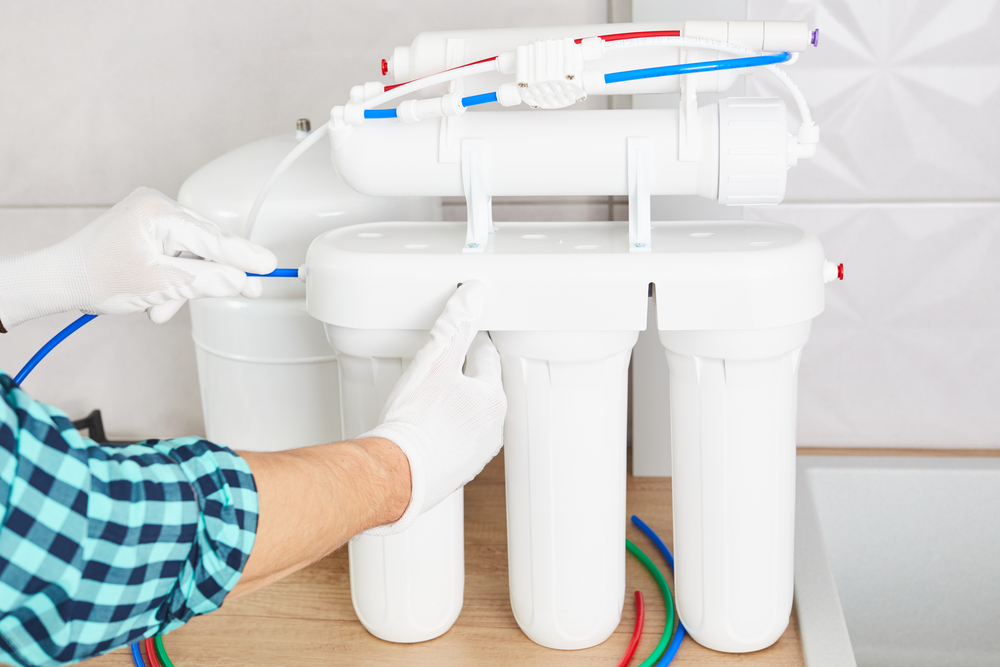You may have found yourself wondering at one time or another, how do water filters work? Water filters in their basic form are a way to remove particles and debris from drinking water and instantly improve the water quality. Normally, water would pass through a series of filtration media such as cloth, stones, charcoal, and more. As it passes through this media, different visible and invisible contaminants and volatile organic compounds in the water are removed, leaving it safe to drink.
Water that comes from natural water sources such as a spring or river can contain a large number of microscopic organisms, some of which may cause stomach upset or long term illnesses. Additionally, some municipally provided water contains chemicals to provide their form of water filtration, which can leave an undesirable taste in your mouth. Certain water filtration methods can trap chemical impurities, leaving you with crystal clear and delicious water quality.
Why Should You Filter Your Tap Water?
Contaminants in your water may refer to a variety of microscopic and larger substances such as toxins, heavy metals, natural earth sediments, bacteria, viruses and more. They can be both naturally occurring in the earth or run off man-made pollutants.
For example, water obtained from ponds, lakes, or swamps will contain many microscopic organisms and other contaminants that live in the soil and on the plants. This is natural, but if you drink them, it can lead to illnesses and potential diseases. Bottled water can get expensive over the long term, so water filtration systems in your home or place of work are an excellent alternative.
While there is almost always some form of contaminants in drinking water, no matter what source it comes from, including bottled water, only some are harmful to your health. The rest, such as calcium deposits and natural minerals, are often desirable and not a danger at all to have in your water supply. Regardless, it’s wise to consider having filtration systems in your home for the best water taste and cleanest water supply.
Common Water Contaminants
The number of pollutants in water will depend on a few factors. For one, your location can come into play. Some locations around the world are much more prone to water pollution than others.
Additionally, plumbing systems in your home can play a role as well. Older pipes may have copper and lead components which can leech harmful substances into the water. Over time these substances can make you and your family ill.
Some of the common water contaminants that may be present in tap water can include:
- Calcium: One of the most commonly found minerals in hard water. It is extremely common and harmless to drink but may cause unsightly white rings on your drinking glasses.
- Chlorine: Commonly added to drinking water by public water maintenance companies. It is used as a means to remove bacteria but can also leave your water tasting odd.
- Copper: Another commonly found metal in drinking water, especially that which comes from an aged well. Additionally, copper pipes can leech this metal into your water.
- Fluoride: Commonly added to some public water supplies in small amounts. Fluoride generally helps prevent tooth decay but can discolour and cause poor flavour in faucet water.
- Iron: Commonly found in water from wells, iron is not harmful to drink but can discolour water and give it a dirty look. Charcoal filters can remove this discolouring.
- Lead: This can be dangerous if found in drinking water. It can be found in homes with old plumbing systems, and water should be heavily filtered in this case.
- Sulfate: Found in some sources of hard water, it can cause digestive distress in adults and children over a short time. It also releases an unpleasant odour from faucet water.
Differences in Filtration Methods
There is a wide range of different filtration methods that remove pollutants as water passes through it. In fact, you might be able to find up to a dozen specifically unique systems that can filter tap water to some extent. The most commonly used five water filtration methods are explained below.
Basic/Sediment Filtration
The most basic form of water filtration is known as sediment filtration. It is used all over the world and is also the filter used in emergency and survival situations. It’s commonly used in commercial settings and can also be seen as one of the main filter methods in wastewater treatment plants.
A sediment filter system removes larger particles and impurities from water ranging from 1 to 100 microns in size. This includes basic debris such as leaves and sand, as well as some metal impurities like rust, copper, calcium, and silt. Additionally, sediment filters can be used together with an activated carbon filtration unit to double the effectiveness of purification.
Gravity will force water through this system to remove contaminants that other filters may miss. However, when used in an emergency or survival situation, water should be boiled if possible to remove potential bacteria and viruses as the basic filters cannot remove those. Sediment filters are commonly used along with charcoal or reverse osmosis systems to give an all-around sanitisation to your drinking water.
Activated Carbon Filtration
Media for activated carbon filters can be found in both carbon block and gravel form. Both perform the same level of filtration and are extremely common around the world to filter impurities from tap water. Carbon filters are used for both drinking water and aquarium filters, so finding a replacement carbon filter is normally not an issue, regardless of your location.
Activated carbon filters, also called activated charcoal filters, are a black stone-like structure that can be used alone or in combination with other filter units to remove impurities. Carbon is an excellent filter media choice for removing odours or undesirable flavours from your drinking water, such as those caused by chlorine or other chemical purification methods.
Carbon is most commonly used in its granular activated carbon form. It can be found in boxes for you to pour into your filters yourself or in prepackaged replacement filters that you can drop into a filter canister. The filters make for easy replacement over time, though they can last for several months in some cases, which saves on regular maintenance costs.
Reverse Osmosis
You will notice an extremely precise filter process when it comes to Reverse Osmosis or RO filters. During the RO process, water molecules pass through a semi-permeable membrane that holds a less concentrated solution on one side over the other.
Tap water or hard water particles up to 0.0001 microns in size can be filtered through the semi-permeable membrane accurately, which gives RO filtration a 99% capability of removing impurities, including bacteria and viruses. Additionally, RO filtered water can see the significant removal of minerals and dissolved solids, including lead, mercury, iron, calcium, copper and more.
With proper maintenance and upkeep, an RO system can work effectively for up to 3 years before the membrane needs to be replaced. And since RO can remove up to 99% of impurities, you will find it can produce the cleanest drinking water out of most filtration units.
Ion Exchange

Ion exchange may sound like something out of a science fiction novel, but it is actually a highly specialised way to filter water with the use of an electrical charge and a chemical reaction. The main use for ion exchange filtration is to remove minerals and metals, as a result softening the water.
Ion exchange uses a positively charged ion exchange resin as the filtration media. This resin will attract certain mineralised water molecules and exchange them into deionised anions by receiving an electrical charge. This process removes fluoride, magnesium and calcium ions, nitrates, sulfate, chloride, chlorine taste, sodium ions, and more.
An ion exchange system is normally used in combination with a Reverse Osmosis system as well as an Activated Carbon filtration system. The three together can work to eliminate nearly 100% of all water pollution, including generalised minerals, bacteria, and viruses at the microscopic level. Having a reverse osmosis unit in your home is a great way to ensure your home water filter system is providing enough clean water for your needs.
UV Sterilisation
Ultraviolet (UV) sterilisation is not necessarily a filtration system but can be used to help purify drinking water. It is normally used to specifically target and kill viruses and some bacteria. It is most commonly used as a water purification method to target certain strains of E. coli, cryptosporidium, giardia, and more.
It’s an excellent form of filtration for water collected from aged wells and rainwater cisterns, as well as water that comes from a pond or other natural water source. Ultraviolet rays can destroy more than 99.9% of all microorganisms in water, leaving the remaining water perfectly safe to drink.
UV sterilisation should be used in addition to a standard filter that can remove certain metals and chemicals you may find in your water sources. However, UV lights need to be replaced often as their sterilisation capabilities will only last for a few months under normal use.
Why Water Filters Can Be Expensive

When it comes to the cost of water filtration, the range can be huge. It will entirely depend on what type of filtration system you want and whether or not you want it to provide enough filtered water for your entire home or not. You will also have to consider not just the cost of the filtration system itself but also professional installation costs and ongoing maintenance costs.
Additionally, the more thorough a filtration system is, the higher the cost will be. For example, the two most common types of water filtration units are carbon filtration and reverse osmosis systems. One is much more affordable than the other, but both can provide unique filter methods.
For example, carbon filters are an especially useful process for removing chlorine, some metals, and many organic contaminants. On the other hand, reverse osmosis has the capability of filtering water and removing most contaminants under 0.001 microns in size. Because of this attention to detail, RO systems are much more costly than carbon but provide some of the best-filtered water for home and office use.
Install a Water Filter for Your Home
Water treatment systems of some kind, either basic or elaborate, are an extremely important and sometimes vital requirement to have a safe and clean drinking water supply in your home. You can use a single basic sediment system or run your water through multiple filtration systems working in tandem to get a perfect combination of filters, leaving you with crystal clear delicious water.
Now, you have known the answer, “how do water filters work?”. Regardless of what filter system you choose for your home, you can rest assured knowing you are helping to limit the number of organic compounds, metals, general pollutants, and microorganisms present in your drinking water.

